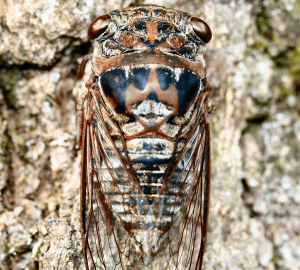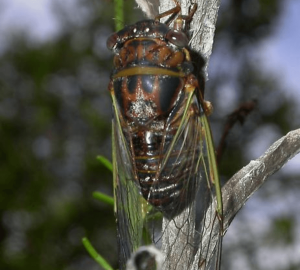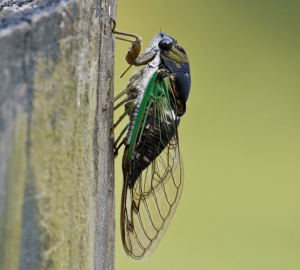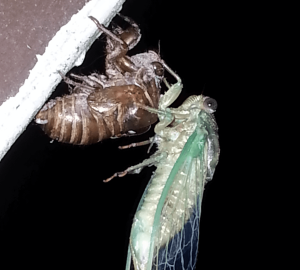If you’ve ever spent a summer in Florida, you’re likely familiar with the loud, eerie buzz of the cicada. That buzz is actually the males’ mating call, and by their standards, the louder it is, the better. This sound is produced by their tymbals, a pair of drum-like structures on either side of the abdomen.
Now, you may have heard the recent news about the biggest cicada emergence to occur in 221 years. Trillions of cicadas are estimated to emerge throughout the summer season in several U.S. states. The cicadas responsible for this event are known as periodical cicadas, and they belong to the genus Magicicada. There are two broods that will be emerging simultaneously: Brood XIX and XIII. This is the first instance since 1803! This strategy of “strength in numbers” allows many of these cicadas to survive predation.
While other states may be experiencing a historically loud summer, Florida will not. That is because we do not have any periodical cicada species. Our cicada species are annual, meaning that they occur every year. Even though we won’t be having the same experience as others across the country, now is a great opportunity to get to know our local cicadas.
Keep reading to learn about some of our most common species, their lifecycle, and ways to manage them.
Common Cicadas of Florida
Hieroglyphic cicada (Neocicada hieroglyphica)

Length: 23-32 mm
Season: April-August*
Habitat: Partial to oak trees
Description: This species has a green and brown base color with black markings on its body that are said to resemble hieroglyphics. It is often found in small colonies and is one of the first to be heard in the spring. Its song has been described as “a model airplane warming up its engine.”
Resonant cicada (Megatibicen resonans)

Length: 31-57 mm
Season: May-October*
Habitat: Pine and oak trees
Description: The resonant cicada is one of the largest cicada species in North America. Its body is mainly black and brown with a frosted white underside. Its call could be described as a rapid rattling, followed by a single, drawn out note.
Davis’ southeastern dog-day cicada (Neotibicen davisi)

Length: 31-57 mm
Season: June-December*
Habitat: Partial to pine trees
Description: Dog-day cicadas earned their nickname by being the most active during the “dog days” of summer, or when the season is at its peak heat. Neotibicen davisi, or Davis’ southeastern dog-day cicada, is a large-bodied cicada, and its coloring can range from brown to green. Its call closely resembles a loud buzz saw and lasts for about 10 seconds.
Olympic scrub cicada (Diceroprocta olympusa)

Length: 23-32 mm
Season: May-September*
Habitat: Partial to pine trees; found in scrub, pine flatwoods, open fields, and roadsides
Description: The Olympic scrub cicada is one of the most widely distributed species in the state of Florida. They are usually black, brown, and green with a frosted white underside. Its call can be described as a continuous, droning buzz.
Swamp cicada (Neotibicen tibicen)

Length: 31-57 mm
Season: June-September*
Habitat: Low vegetation and shrubs in swamps, uplands, and overgrown fields
Description: Otherwise known as the morning cicada, this cicada species is known to call in the bright, early hours of the day. It has a rounded back, and its color can be a variation of green and black or green and brown, with a frosted white underside. Its wings are often bright green at their base. The call of the swamp cicada begins as a quiet, soft buzz, progressively getting louder before it quickly quiets and stops.
Life Cycle

As with most insects, it all begins with an egg. In this case, it’s laid in the branch of a tree or shrub by a gravid female (that is to say, a female that’s carrying eggs). After about six to 10 weeks, that egg will eventually hatch into a cicada nymph and fall to the ground. It will then spend the rest of its nymphal stages underground in the soil.
For nutrients, it will feed on the xylem sap that flows through the roots of plants. Compared to phloem sap, xylem sap is relatively low in nutrients. This is partly why it takes so long for cicadas to emerge from the soil. The average is two to five years, in fact! Every cicada goes through four instars, or stages of growth, before emerging from the soil to molt into their adult form.
Each cicada will leave behind a hollow exoskeleton (pictured left) during this amazing transformation. You may have seen or even collected a few through the years. They can often be found on the base of trees, palms, and plant stems.
Management
Although you may be fair in accusing cicadas of being, ahem, noisy, they do not pose a threat to our local ecology. In fact, they serve as an important food source to a variety of animals, such as birds, rodents, reptiles, and even bats. While you may find yourself occasionally annoyed by their mating calls, it’s important to remember that, like many things in life, they are just temporary. So, I encourage you to sit back, relax, and even enjoy the sounds synonymous with summer.
Learn More
Watch the video below to learn more about our local cicadas from Dr. Adam Dale, UF/IFAS entomologist.
Resources
- SINA – Cicada songs (listed above), recorded by T.J. Walker
- UMass Extension – Magicicada spp.
- UConn – The 2024 Periodical Cicada Emergence
- UF/IFAS Featured Creatures: Cicadas (of Florida)
- UF/IFAS – Cicadas in Florida
*Seasonality data taken from iNaturalist observations in the state of Florida
 10
10
